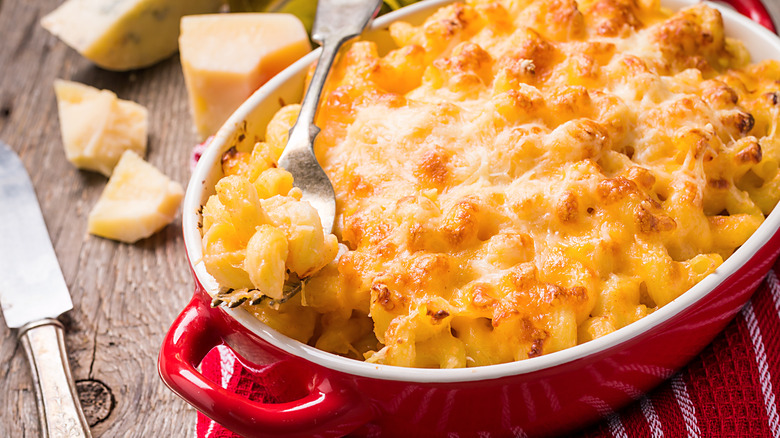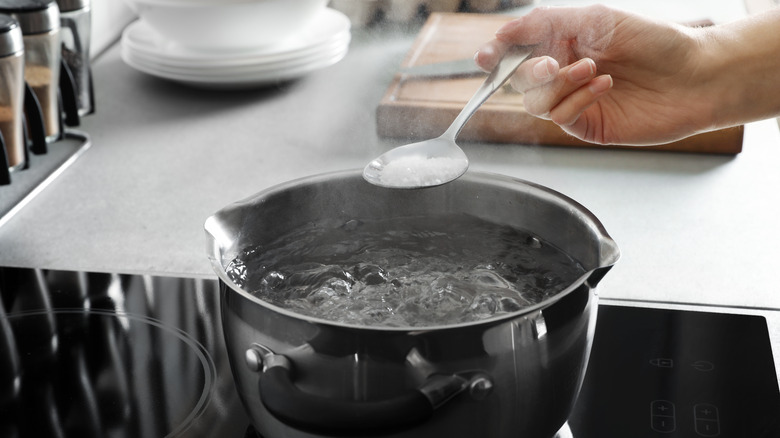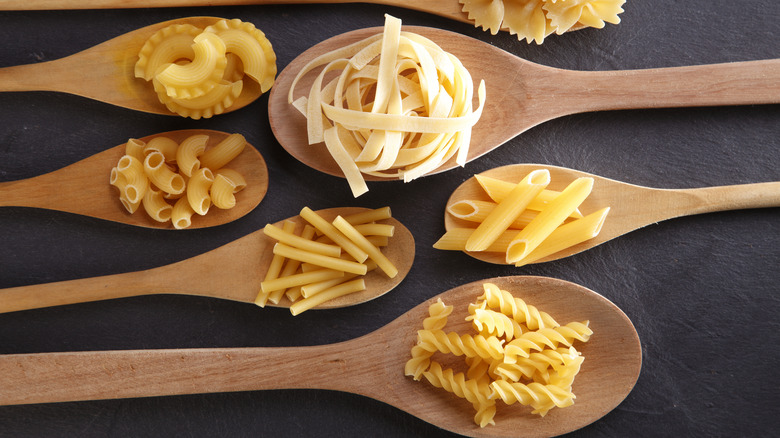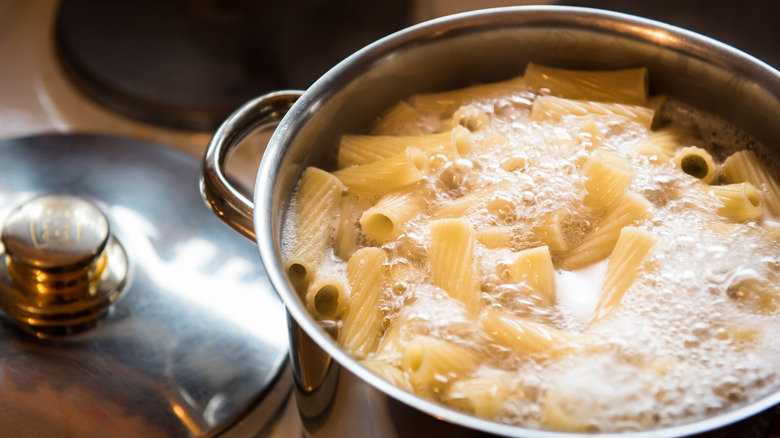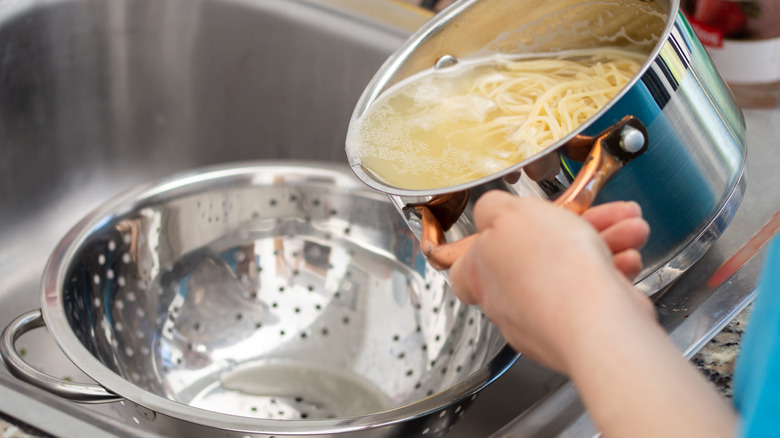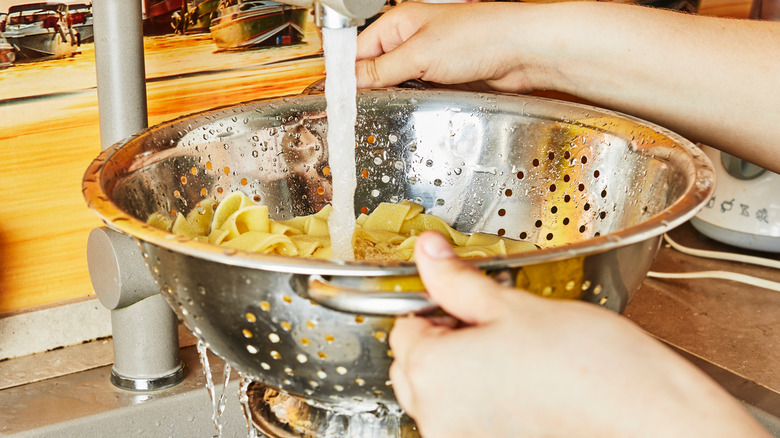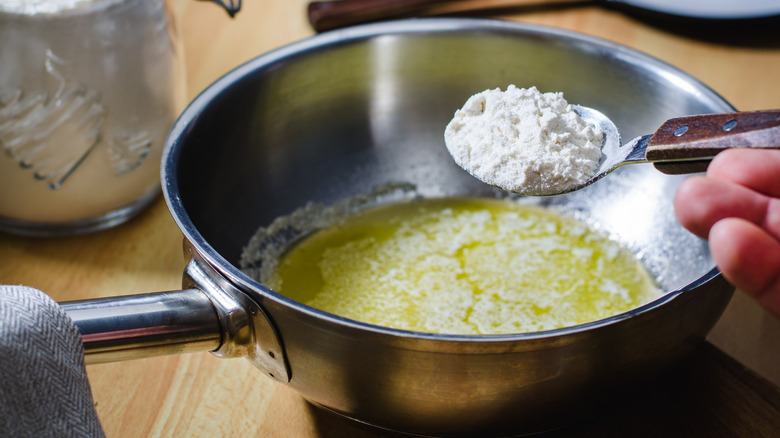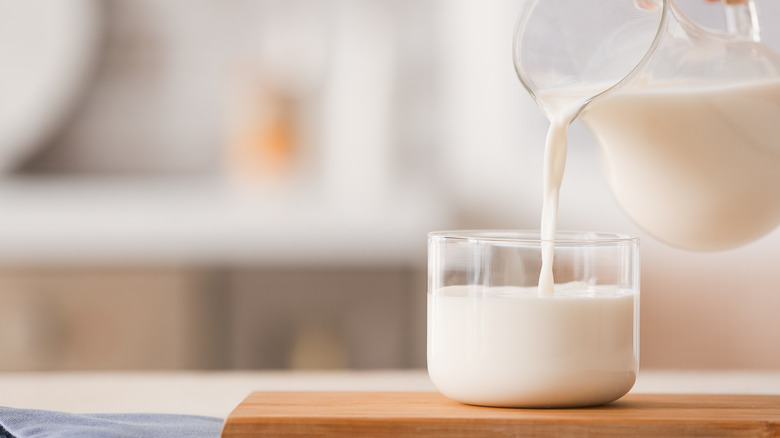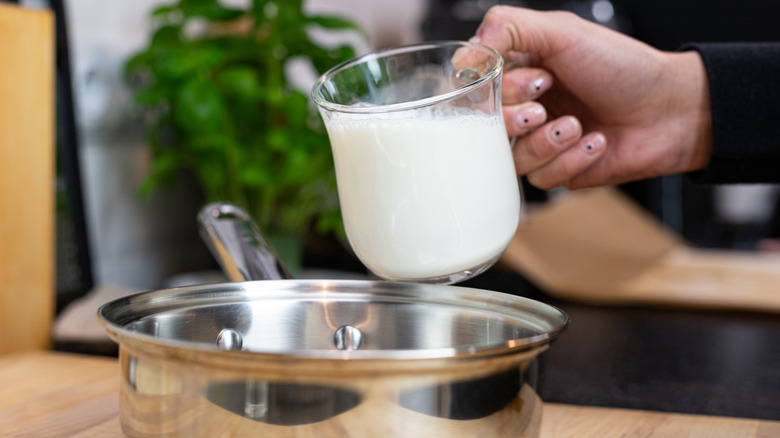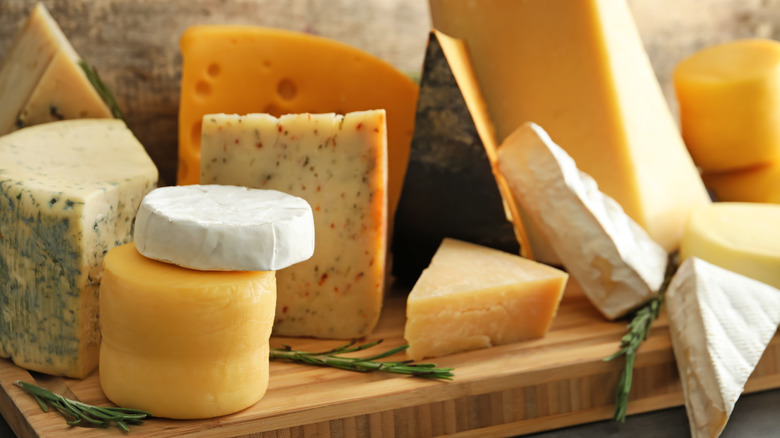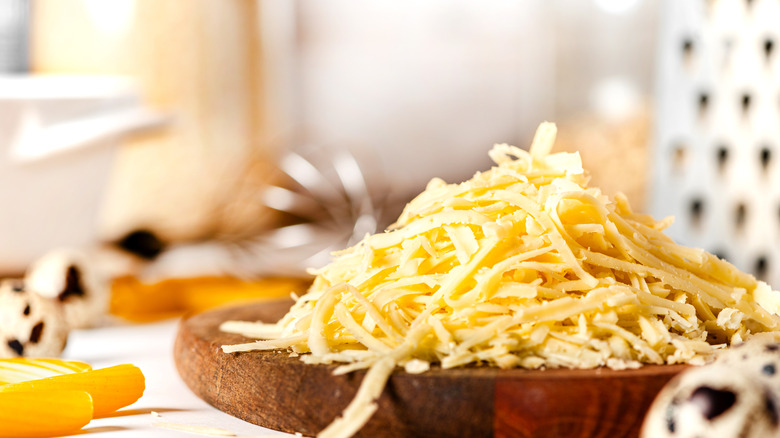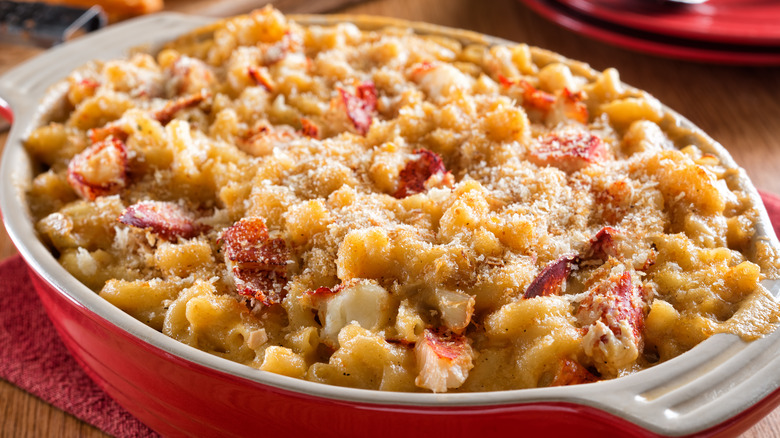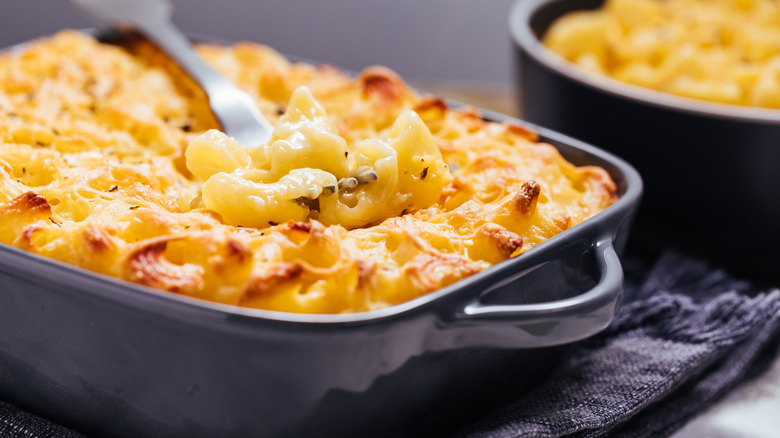12 Mistakes You Need To Avoid With Mac And Cheese
Mac and cheese is versatile comfort food. We see it on tables everywhere. People bring this comfort food to potlucks and BBQs, they serve it at family dinners, and it's even a beloved solo weeknight treat. Mac and cheese is a simple, no-fuss meal that even novice cooks can whip up and enjoy. The ingredients are affordable, and it requires no special kitchen equipment. What more could you ask for in a recipe?
Despite its popularity and simplicity, there is no one-size-fits-all cooking technique for mac and cheese. And mac and cheese methods can get pretty controversial. Every family has its own recipe and a particular set of rules to follow. Some mac and cheese recipes are baked, some are one-pot stovetop dinners, and some have seven different types of cheeses. No matter how you make it or where you eat it, just be sure that you don't fall victim to these common mac and cheese mistakes.
Not salting the pasta water
Great mac and cheese starts with the pasta. And great pasta begins with water that's been heavily salted. We're talking ocean water levels of salt. Not adding salt to your water leads to bland, tasteless noodles. This, in turn, leads to a finished product that is flavorless even after adding the cheese sauce. You could end up having to overseason a part of your dish to make up for the bland pasta. The worst part? It almost never fully makes up for the lack of salt in the noodles. In fact, food science research shows that pasta loves to soak up sodium out of boiling water (via the National Library of Medicine).
Pasta water needs more salt than you think, and according to legendary food author Marcella Hazan, you should add it after the water is boiling. A good rule of thumb is to use around 1½ tablespoon of kosher salt per pound of noodles. If your recipe includes cheeses with lower sodium content, like Swiss or cheddar (via Nutritionix), you can add slightly more, bordering on an average of 2 tablespoons per pound. But, if your recipe calls for higher sodium cheeses like American or parmesan, opt for a tablespoon instead.
Choosing the wrong pasta shape
Even if you salt your water perfectly, choosing the wrong pasta shape for mac and cheese can ruin everything. Italy Magazine writes that there are catalogues of upwards of 350 types of pasta to choose from for your meals. But only a handful will really work for mac and cheese. Elbow macaroni is arguably the most popular pasta shape for this cheesy dish. Elbow macaroni was made popular by Kraft in 1937 during the Great Depression (via Smithsonian Magazine). These crook-shaped noodles are sturdy and invite sauce deep into a hollow tunnel, meaning you get a perfectly cheesy bite every single time.
There are plenty of other types of pasta shapes to choose from. For a thick cheese sauce, shorter forms hold up best. You'll want to avoid long, thin noodles like spaghetti or fettuccine because they will clump together and become a gummy mess. Too small of a shape, like an orzo, will turn into mush. And too-large shapes like lasagna won't hold onto the sauce properly. Short noodles like elbows, cavatappi, shells, or even gemelli are mac and cheese soul mates. These sturdy varieties of pasta won't lose their shape, and their crevices are perfect for retaining mac and cheese's rich creaminess.
Overcooking the pasta
We all know what happens when pasta boils for just a few minutes too long. The noodles become soft and fall apart easily. Soggy pasta is exactly what you want to avoid, especially in mac and cheese — too soft, and you'll be eating cheese sludge with a spoon. Instead, for a hefty cheese sauce, you'll want your noodles cooked al dente. Cooking pasta al dente means the pasta is cooked through but retains a slight bite. The phrase al dente means "to the tooth," and it is the sweet spot between crunchy uncooked noodles and a gelatinous mess of pasta.
To reach the perfect al dente doneness, there are a few pasta mistakes you should avoid. Always use a pan that gives your noodles enough room to cook evenly. A pan that is too small causes them to clump, and you'll end up with undercooked and overcooked pieces. You'll also want to taste your pasta several times as it cooks. Start tasting two minutes before the package directions say to drain it. Tasting the pasta is the most reliable way to avoid overcooking or undercooking and to ensure an al dente finish.
Not saving the pasta water
Pasta water is the secret weapon in mac and cheese. Pouring it down the drain is an amateur mistake. As the noodles boil, the water becomes starchy and flavorful. Pasta water is also a quick and easy way to thin out a sauce that is too thick. Cheese sauces can get heavy and gummy, but using a little pasta water to loosen the sauce without compromising the taste will forever keep this from being a problem during your mac and cheese moments. Try keeping a glass measuring cup next to your boiling water as a reminder to save the water before draining.
The types of unseasoned liquid often used in mac and cheese tend to change the flavor of the dish in subtle ways. Using plain water from the tap dilutes the flavor of your mac in a way that using starchy pasta water does not. Similarly, adding milk is a good way to make your pasta creamy, but it runs the potential of making your sauce too rich. With either of these additions, you'll need to constantly taste your pasta, adjusting seasonings again and again — especially if you need to keep adding liquid as the sauce cooks down. Saving some pasta water is a simple solution. However, if you forgot to save your pasta water, you can create a slurry with cornstarch, water, and salt.
Rinsing the cooked noodles
The key to a delicious mac and cheese is a sauce that sticks to the noodles. To ensure the sauce clings correctly, you want to avoid rinsing the pasta after it has finished cooking. In fact, the only time you should be rinsing pasta is if you're serving a cold or room temperature dish. Noodles that have not been rinsed will hold on to some of the starch from cooking, giving the cheese something to grab on to. This tip makes a saucier, creamier mac and cheese.
Additionally, let this be another good reason to keep your pasta water. Using starchy water not only helps to thin out your sauce, but starched water also helps the sauce cling to the drained pasta much better than other options like milk or water, as starch is a common food binder (via Grand View Research). If you have not reserved any pasta water, adding the drained pasta immediately to the cheese sauce is an excellent way to ensure the cheese will seep into every crevice and stick to every inch of surface area.
Not starting with a roux
While cheese and pasta are well-known as a match made in heaven, a luscious mac and cheese recipe requires a velvety sauce. The best silky sauces start with a viscous, binding base such as a roux. A roux is a thickening agent made with equal parts flour and fat, and it is a fundamental technique for the kitchen. This thickening concoction is what gives mac and cheese its thick and rich consistency. We suggest you avoid most mac and cheese recipes that don't use a roux as a base. Skipping this step can result in watery mac and cheese, and nobody wants that.
To make a roux for mac and cheese, start by melting unsalted butter until it begins bubbling in the pan. Then add all-purpose flour and cook the flour taste out. It's best to judge the doneness of a roux by its color. For mac and cheese, cook the roux to a golden yellow color. Cooking it for longer will cause it to be brown, though a darker roux is usually reserved for gravies and gumbo.
Using the wrong milk
Like pasta shapes, there are dozens of milk and milk substitutes for cooking. Theoretically, you can choose from any of these when making mac and cheese. However, unlike pasta, there's only a small handful of truly acceptable milk choices. For anyone who consumes dairy, you should only use whole milk when making mac and cheese. Mac sauce starts as a béchamel, which is a light-color roux with milk (via Escoffier). Whole milk has a fat content of 3.25%, which is a great ratio of fat to water content to make a rich sauce. Skim milk can result in a watery or oily texture. Following this, plant-based eaters or lactose-intolerant folks may be tempted to use any popular milk alternative with a similar consistency, such as oat milk. We caution against that choice in particular, as oat milk has a nutty sweetness. While that's great for coffee, the taste is hardly what we're looking for in a salty and savory mac. Instead, go for alternatives with more neutral profiles and fattier compositions, such as soy or hemp milk.
What if you want to make healthier mac and cheese? You should still stick to whole milk. While some dairy products have gotten a bad reputation in recent years, full-fat dairy products may not be as bad as you've been led to believe. Healthline explains that recent studies refute correlations between full-fat dairy and heart disease or stroke as previously considered. Go ahead and add the full-fat milk.
Adding milk to the sauce too quickly
Another tip for a luscious and creamy mac and cheese is to add the milk slowly to the roux and constantly stir as you do. Lumps are among the biggest things you want to avoid when making a béchamel-based cheese sauce. The best way to prevent clumps is by never letting them form in the first place. Adding ingredients slowly and stirring non-stop will stop any blobs of flour from forming. If you do start to see lumps appear, whisk vigorously until they disappear. If you walked away from your pan and forgot to stir continuously, it will be okay. Cool the sauce and try this hack to fix lumps in your cream pasta sauce by using a blender.
There are also differing opinions about adding cold, room temperature, or hot milk to the roux. While the temperature of the milk largely doesn't change the outcome, it can change the cooking process. Adding cold milk is one mistake everyone makes with béchamel and it can cause longer cook times and can also lead to messy splattering when added to a hot roux. No matter the temperature of the milk, adding it slowly and stirring constantly will result in a silky, lump-free mac and cheese.
Not choosing the right cheese
Choosing the right cheese (or cheeses) is as important as selecting the right noodles. Some cheese varieties just don't melt well. No offense to those cheeses; they're great for other things. But for silky, succulent mac and cheese only the creamiest, liquefying cheeses will do. If you do find yourself craving a specific cheese — one that isn't known to add creaminess to the sauce — you can absolutely still use it. Just be sure to apply it in moderation and pair it with a cheese that will diffuse into the sauce rather than employing it as the bulk of the base.
The best cheeses to use for mac and cheese are cheddar, Gruyère, fontina, Parmesan, Gouda, and American. These cheeses are made for melting and add the perfect gooey texture to your mac and cheese. Stay away from hard, dry cheeses. Feta, cotija, and queso fresco all have wonderful flavor but won't disperse into the sauce as their melty counterparts do. If you love the idea of feta in your mac and cheese (and who wouldn't?), you could try pairing it with a compatible melting cheese like Gouda or adding it as a finishing touch.
Using pre-shredded cheese
Let's say you've picked the perfect cheese for your macaroni. You even saved time by perusing the pre-shredded section at your local grocery store. Stop right there and put that plastic bag back on the shelf. Pre-shredded cheese is not the best choice for this dish. It may be convenient, but it has a fine powder coating to it that you should be aware of.
The powder coating used to prevent clumping is called cellulose. You may wonder, "what is cellulose, and why is it in cheese?" It is a fiber that you'll find in vegetables, fruits, plant leaves, and tree bark (via Healthline). While it's shocking to some that we eat "wood pulp," it's perfectly safe to consume. It may not be dangerous to eat, but it can create a gritty texture in your mac and cheese. The cheese will melt beautifully, but the powder coating won't dissolve, leaving the unwanted pulp in your sauce.
The best way to avoid unwanted texture is to grate your own cheese from a block. One hack to stop grated cheese from clumping is to use cooking spray. If the thought of grating cheese makes you want to run for the hills, check your food processor before you head out. Most of the appliances have a shredder blade that will tear an entire block of cheese in under 30 seconds. However you grate your cheese, you'll end up with a much better mac than if you'd used pre-shredded options.
Not considering toppings
There may be some purists out there that think mac and cheese toppings are offensive. We're here to say that the right toppings can take a basic mac cheese recipe and punch it up to another level. Classic instructions for the dish can be a little lacking in the texture department. This is where toppings really up the ante. With the addition of a crispy, salty, crushed potato chip topping, a baked mac and cheese recipe becomes a satisfying casserole. The added consistency of a topping alleviates that "something is missing" feeling, giving you crunchy satisfaction and maybe even an added flavor.
When choosing ingredients for mac and cheese toppings, consider both the texture and flavor of those ingredients. Bacon adds a nice savory flavor and a salty bite, while bread crumbs add a flaky layer of texture throughout the dish. Fried onions are another unexpected and flavorful twist. Adding parmesan to a baked mac and cheese recipe gives the top a saline crust. No matter which topping you choose, adding that extra surface layer adds flavor and is never a mac and cheese mistake.
Baking for too long
Baking mac and cheese can create an oh-so-wonderful crust of browned cheese around the sides and on the top. But even our best intentions for an amazing mac can fall flat if taken over the top. Baking mac and cheese adds extra cooking time, leading to overcooked pasta and a dried-out sauce. That's why many mac and cheese connoisseurs recommend sticking to the stovetop for the creamiest homemade mac and cheese.
But some families do have strict mac rules. If the law in your family is to bake the mac and cheese, there are two things you can do to prevent it from becoming mushy or drying out. Be sure to cook your pasta al dente. This will give it a little room to cook longer in the oven and safeguard the pasta from getting too soft. You'll also want to make your sauce a little looser if you're baking it. This is a great time to use that reserved pasta water. It will ensure that the mac and cheese won't dry out while you wait for those edges to get nice and crispy.
